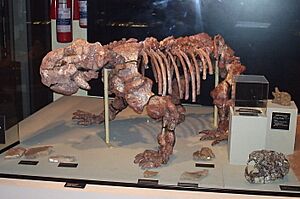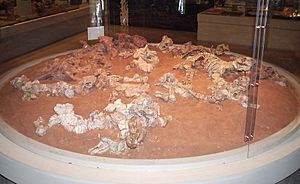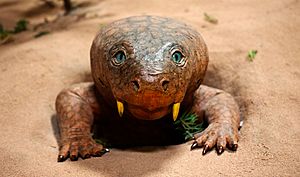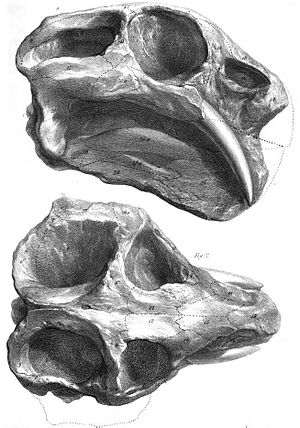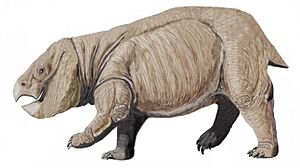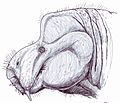Dicynodont facts for kids
Quick facts for kids Dicynodonts |
|
|---|---|
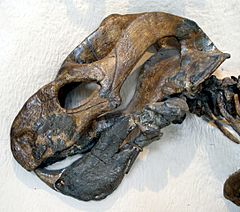 |
|
| Endothiodon, a Permian dicynodont | |
| Conservation status | |
|
Fossil
|
|
| Scientific classification | |
| Kingdom: | |
| Phylum: | |
| Class: | |
| Order: | |
| Suborder: |
Anomodontia
|
| Infraorder: |
Dicynodontia
Owen, 1859
|
The Dicynodontia (say "Die-sy-no-DON-tee-uh") were a group of ancient animals called therapsids. These animals lived long before dinosaurs. Their name means 'two dog tooth' because many of them had two tusks.
Dicynodonts were plant-eaters, also known as herbivores. They were very successful and diverse, with over 70 different types (called genera) found so far.
All dicynodonts had a similar body shape. They looked a bit like small tanks, with strong legs. They weren't fast, but they were powerful. They probably lived in groups, much like many plant-eating animals do today. Their bodies were similar to modern pigs or rhinoceroses.
Fossils found in Poland show that some dicynodonts lived until the very end of the Upper Triassic period. There are also some bone pieces found in Australia that might mean dicynodonts lived even longer, into the Cretaceous period.
Dicynodonts were a type of therapsid, but they were not the ancestors of mammals. The group that eventually evolved into mammals was called the cynodonts.
Contents
What Dicynodonts Looked Like
Dicynodonts had a very special skull. It was light but strong. The back of their skull had large openings for big jaw muscles. The front of their mouth and lower jaw were usually narrow and had no teeth, except in some early types.
Instead of teeth, the front of their mouth had a hard, horny beak. This was like the beaks of turtles or some dinosaurs. When they closed their mouth, their lower jaw moved back. This created a strong cutting action, which helped them eat tough plants. Many dicynodonts also had a pair of tusks. These tusks might have been different between males and females, a feature called sexual dimorphism.
Their bodies were short, strong, and barrel-shaped, with powerful limbs. In larger types, like Dinodontosaurus, their back legs stood straight. But their front legs bent at the elbow. Both their shoulder bones and hip bones were big and strong. They also had a short tail.
Warm-Blooded or Not?
Scientists have long wondered if dicynodonts were warm-blooded animals. Their bones have many tiny channels for blood vessels. Their body shapes also helped them keep warm. Young dicynodonts had even more of these blood channels in their bones.
However, some studies on fossilized droppings (called coprolites) from dicynodonts show that their digestion was slow. This is more typical of animals that are not warm-blooded.
More recently, tiny pieces of hair have been found in some very old coprolites from the Permian period. These coprolites came from meat-eating animals. Since dicynodont bones are often found in these coprolites, it's possible that some of the hair came from dicynodonts. This suggests that dicynodonts might have been warm-blooded after all.
How We Discovered Dicynodonts
People have known about dicynodonts since the mid-1800s. A geologist from South Africa, Andrew Geddes Bain, first described them in 1845. He found many reptile fossils while working on roads in South Africa.
Bain wrote about these fossils in a letter, calling them "bidentals" because of their two tusks. In the same year, a famous English paleontologist named Richard Owen named two dicynodont species from South Africa: Dicynodon lacerticeps and Dicynodon bainii.
Owen later published a more detailed description of these fossils. In 1860, Owen officially named the group "Dicynodontia." This name became very popular and is still used today.
Their Journey Through Time
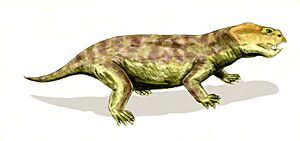
Dicynodonts first appeared during the Middle Permian period. They quickly spread out and became very successful. They were the most common land animals during the Late Permian. During this time, there were many different kinds. Some were large, some medium, and some small. There were even some that burrowed like moles.
Only a few types of dicynodonts survived the huge extinction event at the end of the Permian. One of these, Lystrosaurus, became very common in the earliest Triassic period. However, most of these survivors did not last long into the Triassic.
The only group of dicynodonts that really thrived in the Triassic was the Kannemeyeriiformes. These were sturdy animals, about the size of pigs to oxen. They were the most common plant-eaters around the world for a long time in the Triassic. But later, other reptiles and cynodonts took over their role.
By the middle of the Late Triassic, dicynodonts became much less common. This might have been because the climate became drier. Large plant-eating dinosaurs, called sauropodomorphs, then became the main big herbivores.
Fossils from Poland show that dicynodonts survived until the very end of the Triassic. There are also some bone fragments from Australia that might suggest dicynodonts lived into the Cretaceous period in the southern part of the world. However, some scientists are not sure about these Australian fossils.
After the dicynodonts died out, there were no other dominant large plant-eating animals that were related to mammals for a very long time. It wasn't until about 60 million years ago, after the dinosaurs died out, that mammals (who came from cynodonts) started to become very diverse.
Images for kids
See also
 In Spanish: Dicynodontia para niños
In Spanish: Dicynodontia para niños


